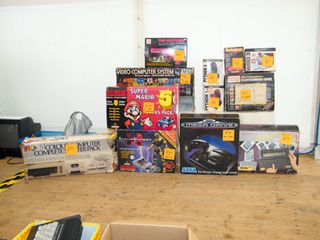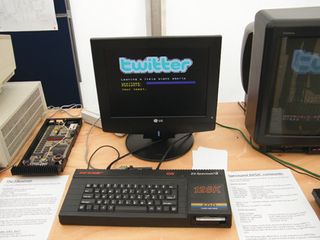Some may think that this interest in older machines is just about clinging on to a bygone time, but Murrell thinks there's more to it. "It's not just nostalgia," he says.
"TNMOC's primary aim is education – we hope to inspire the next generation of computer scientists, and all the evidence is that we are doing just that. By working with vintage machines, it's much easier to get a better appreciation of how they work. A visit to TNMOC takes people beyond applications and helps them understand much more clearly how computers actually work."

One of the exhibitors, Andy Spencer of the Retro Computer Museum, agrees. "Older machines are simply better systems," he says with a smile. "If you want to write a game on a PC or Mac, you usually need an expensive bit of software to start programming. On older machines, nine tenths of the operating system – including a programming language – was built in. You turn the machine on and there it is, so within minutes, and at no extra cost, you can write some basic games."
The fact that these classic micros still have something to offer to people today was backed up by the number of families in attendance at the VCF. As a delighted Simon Hewitt says, "There were five-year-old children engrossed in 25-year-old computer games. I doubt anyone predicted that."
Micro-maintenance isn't just the preserve of big institutions such as TNMOC, as the lengthy list of exhibitors at the VCF made abundantly clear. There are still clubs up and down the country dedicated to particular machines, where fans meet to discuss and swap tips on maintaining and programming their vintage models.

What's even more impressive is that these fans are constantly re-inventing the ways in which these machines can be used. The Sinclair ZX Spectrum on display running a Twitter client was testament to that, as was a playable port of Guitar Hero for the Commodore 64.
Or how about creating internationally acclaimed music with classic computers? That's what PixelH8, AKA Matthew Applegate, who performed at the VCF, uses his old machines for. Every sound in his songs is programmed from scratch and performed on software written for machines such as the ZX Spectrum, Commodore 64, Acorn Electron and MSX. Who would have thought that tinkering with 'defunct' machines could lead to you collaborating with Damon Albarn and Imogen Heap?
Get daily insight, inspiration and deals in your inbox
Sign up for breaking news, reviews, opinion, top tech deals, and more.
Amiga power
The power of vintage computing fans shouldn't be ignored either. It's unlikely that the latest iteration of the Amiga, which made its debut at the VCF, would exist if it wasn't for the strongly devoted and almost rabidly loyal Amiga fan base.
Called the AmigaOne X1000 (it's named after the original Amiga 1000, released by Commodore back in 1985), it runs the operating system AmigaOS4. As one of the organisers of the Amiga area at VCF, Michael Carrillo of Amiga North Thames, explains,
"There are a lot of ex-Amiga users out there who would dearly love to see the Amiga make some sort of niche market comeback. The Amiga computer was marketed in Europe as a games console, only with a keyboard.
"It was the Xbox/PlayStation/Wii of its day, so obviously it holds a lot of nostalgia for the folks who played the games. Sadly, what most people in Europe who owned the old 'Classic' Amiga don't know was that buried and probably forgotten at the back of the cupboard was a very powerful, compact operating system. Now they're all using Windows or Mac OS X or Linux and are unaware of what they had within easy reach."
Other people at the festival were drumming up support for new clubs, including Sean Billings of www.vintagecomputerclub.org.uk. As he explains, "I originally wanted to set up a museum to showcase the private collection that I've built up over the years, but I decided that a museum was a bit hands-off as, after all, the fun is in using them, playing games, learning to program them and so on."
Sean used to be an engineer working on these machines, and he's keen to keep them in the public eye. He says, "Luckily, there are still a lot of the original people around who have a working knowledge of these systems, but this could so easily be lost if younger generations aren't interested in what preceded their iPhone or Netbook."
The message from the VCF's collected masses, united by their love of vintage computing, was crystal clear: get involved. Get active. Who knows, the next person your collection inspires may be the computer scientist of tomorrow.
We'll leave the last word to Simon Hewitt of TNMOC. We asked him what the most exciting thing about working with vintage computing was. He answers,
"The bated breath as you wait to see if something works! Some of these machines may be temperamental, quirky, even plain awkward at times. That's what gives them their character and charm.
"Their capabilities encapsulate a period in time, from the rudimentary interface of the Elliott 803B to the 16-bit graphics of the Amiga 500."













